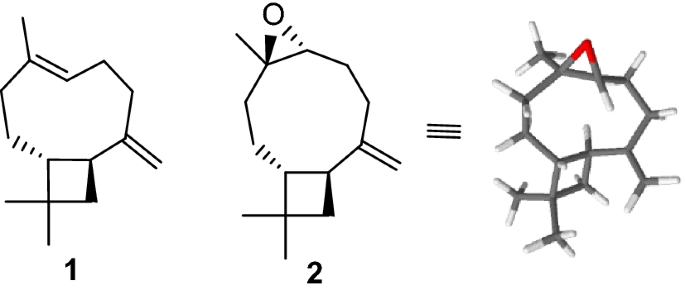A New Breakthrough in Natural Terpenes: Caryophyllene Oxide (BCPO) Highlights Multifaceted Value with Broad Prospects in Medical and Industrial Applications
Recently, Caryophyllene Oxide (abbreviated as BCPO), a sesquiterpene compound derived from natural plants, has become a research hotspot in the pharmaceutical, food, and daily chemical fields due to its diverse biological activities and broad application potential. As an oxidized derivative of β-caryophyllene (BCP), this natural ingredient is not only widely distributed in the plant kingdom but also demonstrates remarkable application value in interdisciplinary research.

BCPO boasts abundant natural sources and is not limited to Cannabaceae plants. It is present in common plants such as guava (Psidium guajava), oregano (Origanum vulgare), cinnamon (Cinnamomum spp.), clove (Eugenia caryophyllata), and black pepper (Piper nigrum). Among these, the BCPO content in eucalyptus (Melaleuca stypheloides) essential oil can be as high as 44% [58]. Notably, relatively high concentrations of BCPO have also been detected in fresh horse manure; studies have found that it exhibits a special attractiveness to animals like giant pandas, providing a new perspective for exploring its biological activities. More importantly, toxicological studies have confirmed that BCPO is non-toxic and non-sensitizing [10], laying a solid safety foundation for its cross-field applications.

In the pharmaceutical field, BCPO stands out for its multi-target pharmacological activities. Unlike BCP, it has no significant binding affinity for the CB2 receptor but shows excellent performance in anti-cancer and analgesic effects. Studies indicate that BCPO can block tumor cell proliferation by inhibiting the PI3K/AKT/mTOR/S6K1 pathway, while activating the Src homology 2 domain-containing phosphatase 1 (SHP-1) protein tyrosine phosphatase to inhibit the STAT3 (signal transducer and activator of transcription 3) pathway [60]. In in vitro experiments, it upregulates the expression of pro-apoptotic genes such as bax and caspase 8, downregulates the levels of anti-apoptotic genes such as bcl-2 and mdm2, and increases the content of tumor suppressor proteins such as p53 and p21 [58]. Critically, BCPO can enhance the efficacy of traditional chemotherapeutic drugs; for example, when combined with doxorubicin (DOX), it significantly improves the cytotoxicity of DOX in various cell lines [32, 62]. Additionally, it inhibits the activity of cytochrome P450 3A (CYP3A) in the liver [63]. At concentrations of 13 μM and 25 μM, it inhibits the activities of CYP2C19 and CYP2C9 respectively, as confirmed by quantitative high-throughput screening (qHTS) assays (https://pubchem.ncbi.nlm.nih.gov/compound/6604672#), which is expected to prolong the action duration of relevant drugs.
Beyond its anti-cancer potential, BCPO also demonstrates value in the prevention and treatment of metabolic and neurological diseases. By inhibiting the activity of 15-lipoxygenase (15-LOX), it regulates the production of bioactive lipid metabolites, offering new insights for the intervention of diseases such as type 1 and type 2 diabetes, cardiovascular diseases, hypertension, kidney diseases, and neurological disorders like Alzheimer’s disease (AD) and Parkinson’s disease (PD) [64]. At a dose of 12.5 mg/kg, BCPO exhibits significant central and peripheral analgesic and anti-inflammatory activities [65]. Meanwhile, as an inhibitor of calcium and potassium currents, it holds therapeutic potential for certain types of arrhythmias [66]. Finally, BCPO is a potent antioxidant, bactericide [67], and fungicide [68].
In industrial applications, the versatility of BCPO is equally striking. As a strong antioxidant and antibacterial agent, it serves as a natural preservative in the food industry, extending the shelf life of baked goods, beverages, and other products. In the daily chemical industry, its stable chemical properties make it an ideal ingredient for cosmetic fragrances, with dual functions of preservation and fragrance modulation. In agriculture, its antibacterial and insecticidal activities can be utilized to develop green pesticides, aligning with the needs of sustainable development.
Currently, natural products account for 60% of the sources of anti-cancer drugs, and 64.9% of approved anti-cancer drugs are derived from natural products or their derivatives [1]. As a natural plant extract, BCPO combines safety and multi-effectiveness; its in-depth development in the pharmaceutical field and wide application in industrial sectors are expected to inject new impetus into the health industry and green manufacturing. Industry insiders predict that with the advancement of research on novel carriers such as artificial cell delivery technology, the bioavailability of BCPO will be further improved, and its application scenarios will continue to expand.

